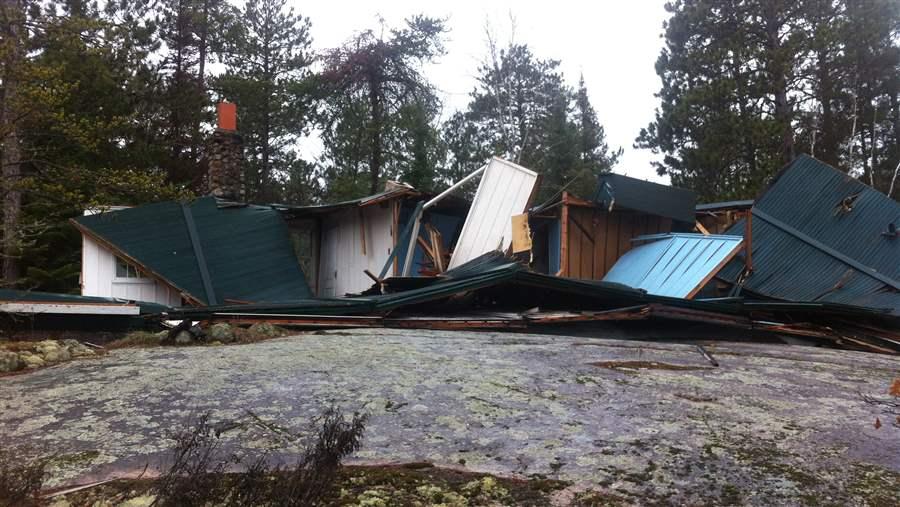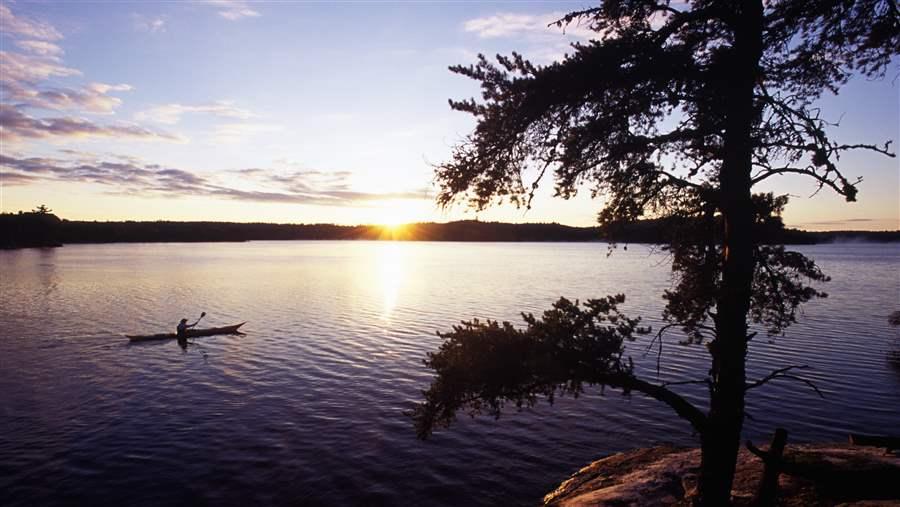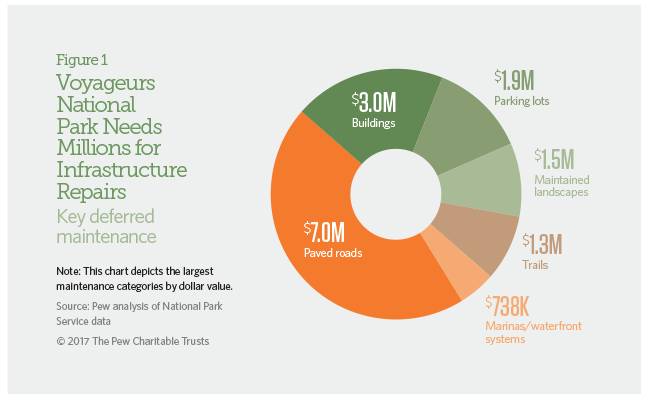Voyageurs National Park
Minnesota
Pew created this case study using National Park Service deferred maintenance data issued in fiscal year 2015. The information listed here may no longer reflect the NPS site’s current condition or maintenance requirements. To find the most up-to-date information, please use the National Park Repair Needs tool.
Overview
With more than 84,000 acres of freshwater dotted with over 900 islands, Voyageurs National Park lives up to Minnesota’s “Land of 10,000 Lakes” moniker. Water covers nearly a third of the park, and boating, canoeing, kayaking, and fishing opportunities abound. And if all that paddling makes you hungry, you can harvest up to a gallon of wild berries a day to snack on. Many areas of the park, which lies along the state’s northern border with Canada, are accessible only by water in the warmer months, but ice roads in winter welcome adventurous drivers. Even this remote wonderland, however, needs more than $16 million in maintenance.

The historic Ingersoll Cabin’s collapse highlights the importance of addressing the more than $16 million repair backlog at Voyageurs National Park.
© National Park ServiceMaintenance challenges
Although most of the park’s deferred maintenance is for roads—totaling $7 million—it also needs to repair non-transportation assets such as campsites, trails, and historic structures. To address the backlog, the park began collecting fees for campsite reservations in 2015. This income stream has helped fund repairs to some campgrounds and other projects, but many others remain. Campsites on small islands that can be accessed only by boat, canoe, kayak, and trails are in high demand, accounting for more than $1 million worth of deferred maintenance. This includes restoring and improving tent sites, maintaining fire rings, and repairing and installing new bear-proof food storage lockers. The lockers protect visitors and safeguard bears by discouraging them from seeking out campers’ food.
Many seawalls and other riprap around lakeshore campsites also need to be strengthened to limit sediment from entering the water. Some docks and paddle-in sites also need repair and preventative maintenance, an ongoing struggle in a climate in which freeze-thaw cycles wear away lakeside infrastructure.
While water is the star of Voyageurs National Park, land-based trails also need to be rehabilitated, at a cost of about $1.3 million. In addition to trail surfaces, many water bars and boardwalks need attention. These features improve the quality of the trails and preserve water quality by managing runoff and preventing trampling of wetlands. A lack of funds also has prevented the National Park Service from improving signage, removing trees and other vegetation, and clearing debris from trails. And it needs to install 2 miles of bike path near an entrance to separate vehicle and bicycle traffic.
Voyageurs National Park offers many wintertime activities, too, including cross-country skiing and snowmobiling. Nearly $250,000 is required to upgrade these trails. Better signage along snowmobile routes also would boost safety and visitors’ enjoyment.
Lastly, more than $700,000 is needed to repoint masonry, shore up foundations, repaint, and reroof the park’s historic buildings, which are mostly former resorts and estates.
Preserving iconic resources in Voyageurs National Park while maintaining access to its lands and waters is important for surrounding communities and visitors alike. That’s why our group works on public/private partnerships to help maintain park resources and provide opportunities for kids to experience nature and learn about stewardship of our public lands.Christina Hausman, executive director, Voyageurs National Park Association
Recommendations
To address the infrastructure needs at Voyageurs and other National Park Service (NPS) sites in Minnesota and across the country, Congress should:
- Ensure that infrastructure initiatives include provisions to address park maintenance.
- Provide dedicated annual federal funding for national park repairs.
- Enact innovative policy reforms to ensure that deferred maintenance does not escalate.
- Provide more highway funding for NPS maintenance needs.
- Create more opportunities for public-private collaboration and donations to help restore park infrastructure.
Voyageurs National Park Facts
2016
| Visitor spending | $19.8 million |
| Jobs created by visitor spending | 310 |
| Economic output | $24.6 million |
| Labor income | $7.6 million |
| Visits | 238,313 |
| Deferred maintenance (fiscal year 2015) | $16 million |
Sources: National Park Service, “Annual Visitation Report by Years: 2006 to 2016,” accessed June 16, 2017, https://irma.nps.gov/Stats/SSRSReports/National Reports/Annual Visitation By Park (1979 - Last Calendar Year); National Park Service, “Visitor Spending Effects,” accessed June 16, 2017, https://www.nps.gov/subjects/socialscience/vse.htm; National Park Service, “NPS Deferred Maintenance Reports,” accessed Aug. 19, 2016, https://www.nps.gov/subjects/plandesignconstruct/defermain.htm
© 2017 The Pew Charitable Trusts
The Pew Charitable Trusts works alongside the National Parks Conservation Association, the National Trust for Historic Preservation, and other national and local groups to ensure that our national park resources are maintained and protected for future generations to enjoy.


National Park Deferred Maintenance Needs


Mississippi National River and Recreation Area


Calls Mount for Congress to Fix Our Parks











